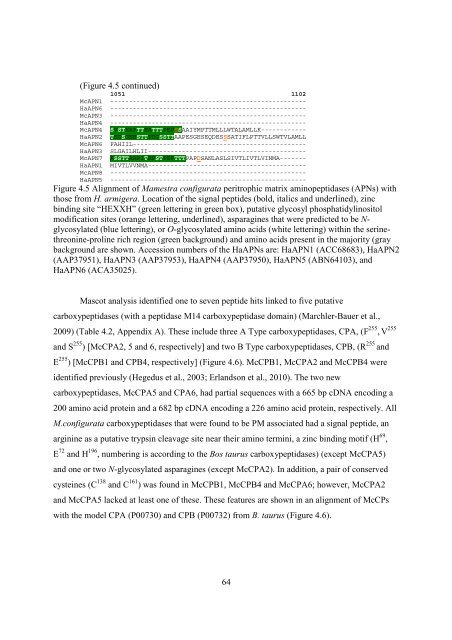Phd Thesis 33 - eCommons@USASK - University of Saskatchewan
Phd Thesis 33 - eCommons@USASK - University of Saskatchewan
Phd Thesis 33 - eCommons@USASK - University of Saskatchewan
You also want an ePaper? Increase the reach of your titles
YUMPU automatically turns print PDFs into web optimized ePapers that Google loves.
(Figure 4.5 continued)<br />
1051 1102<br />
McAPN1 ----------------------------------------------------<br />
HaAPN6 ----------------------------------------------------<br />
McAPN3 ----------------------------------------------------<br />
HaAPN4 ----------------------------------------------------<br />
McAPN4 SVSTEAPTTEATTTPEPSSAAIYMPTTMLLLWTALAMLLK------------<br />
HaAPN2 TEGSGEESTTPDGSSTTAAPESGESEQDESSSATIFLPTTVLLSWTVLAMLL<br />
McAPN6 FAHIIL----------------------------------------------<br />
HaAPN3 SLGAILHLII------------------------------------------<br />
McAPN7 ASSTTAAPITEPSTPEPTTTPAPDSANLASLSIVTLIVTLVINMA-------<br />
HaAPN1 MIVTLVVNMA------------------------------------------<br />
McAPN8 ----------------------------------------------------<br />
HaAPN5 ----------------------------------------------------<br />
Figure 4.5 Alignment <strong>of</strong> Mamestra configurata peritrophic matrix aminopeptidases (APNs) with<br />
those from H. armigera. Location <strong>of</strong> the signal peptides (bold, italics and underlined), zinc<br />
binding site “HEXXH” (green lettering in green box), putative glycosyl phosphatidylinositol<br />
modification sites (orange lettering, underlined), asparagines that were predicted to be N-<br />
glycosylated (blue lettering), or O-glycosylated amino acids (white lettering) within the serinethreonine-proline<br />
rich region (green background) and amino acids present in the majority (gray<br />
background are shown. Accession numbers <strong>of</strong> the HaAPNs are: HaAPN1 (ACC68683), HaAPN2<br />
(AAP37951), HaAPN3 (AAP37953), HaAPN4 (AAP37950), HaAPN5 (ABN64103), and<br />
HaAPN6 (ACA35025).<br />
Mascot analysis identified one to seven peptide hits linked to five putative<br />
carboxypeptidases (with a peptidase M14 carboxypeptidase domain) (Marchler-Bauer et al.,<br />
2009) (Table 4.2, Appendix A). These include three A Type carboxypeptidases, CPA, (F 255 , V 255<br />
and S 255 ) [McCPA2, 5 and 6, respectively] and two B Type carboxypeptidases, CPB, (R 255 and<br />
E 255 ) [McCPB1 and CPB4, respectively] (Figure 4.6). McCPB1, McCPA2 and McCPB4 were<br />
identified previously (Hegedus et al., 2003; Erlandson et al., 2010). The two new<br />
carboxypeptidases, McCPA5 and CPA6, had partial sequences with a 665 bp cDNA encoding a<br />
200 amino acid protein and a 682 bp cDNA encoding a 226 amino acid protein, respectively. All<br />
M.configurata carboxypeptidases that were found to be PM associated had a signal peptide, an<br />
arginine as a putative trypsin cleavage site near their amino termini, a zinc binding motif (H 69 ,<br />
E 72 and H 196 , numbering is according to the Bos taurus carboxypeptidases) (except McCPA5)<br />
and one or two N-glycosylated asparagines (except McCPA2). In addition, a pair <strong>of</strong> conserved<br />
cysteines (C 138 and C 161 ) was found in McCPB1, McCPB4 and McCPA6; however, McCPA2<br />
and McCPA5 lacked at least one <strong>of</strong> these. These features are shown in an alignment <strong>of</strong> McCPs<br />
with the model CPA (P00730) and CPB (P00732) from B. taurus (Figure 4.6).<br />
64















